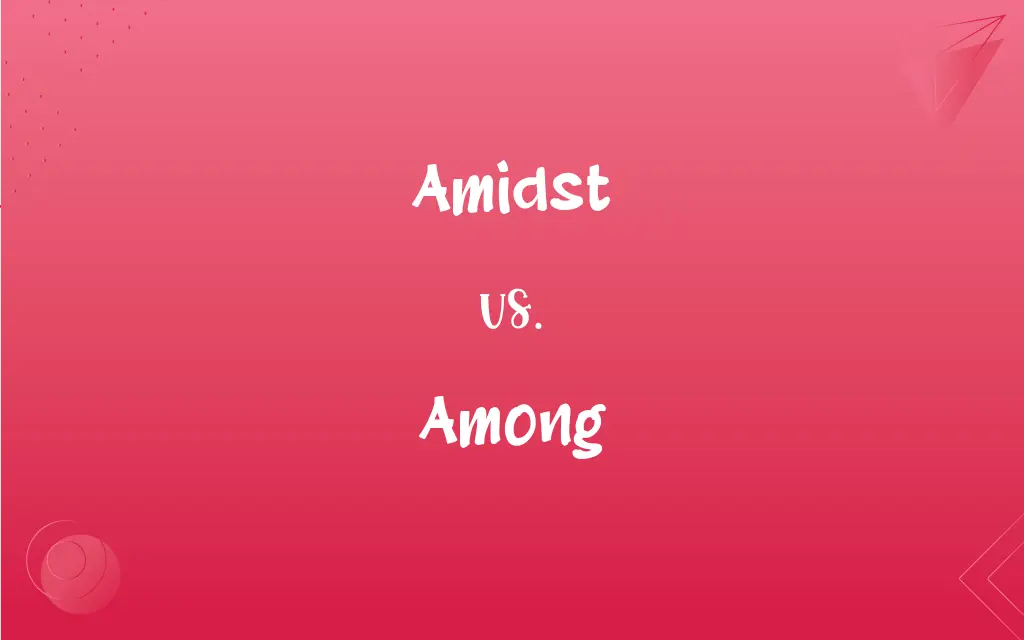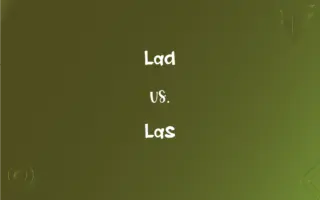Amidst vs. Among: What's the Difference?
By Janet White || Updated on November 12, 2023
Amidst is used to indicate that something is surrounded by or occurring in the middle of something else. Among is used to indicate a presence or position within a group, number, or class.

Key Differences
Amidst is often used to describe a setting or situation where something is in the middle of or surrounded by something else, usually in a more figurative or abstract sense. It implies being enveloped or encircled by the surroundings. Among, however, is used to denote being in the company of or included within a group or collection of items or individuals. It emphasizes a sense of being a part of a larger whole.
The usage of amidst often conveys a sense of being engrossed or encompassed by an environment or situation, such as being amidst chaos or amidst nature. It can imply a deeper immersion or involvement. Among is more commonly used to indicate a simpler, physical presence within a group, like being among friends or among the trees in a forest.
Amidst tends to be more poetic or literary in tone, suggesting a more nuanced or artistic context. It's often used to enhance the descriptive quality of a sentence. Among is more straightforward and is commonly used in everyday language to denote the physical presence or inclusion in a group or category.
In terms of syntactical usage, amidst can be interchanged with 'amid' without changing the meaning significantly. It's more about preference in terms of sound and rhythm in language. Among is sometimes used interchangeably with 'amongst', although 'amongst' is more archaic and less common in modern English.
The choice between amidst and among can also depend on the context and the degree of specificity required. Amidst is more suitable for abstract, general, or figurative contexts, whereas among is often used for more specific, literal, or concrete descriptions.
ADVERTISEMENT
Comparison Chart
Usage Context
Figurative or abstract surroundings
Physical presence in a group or collection
Connotation
Immersion or involvement in an environment
Being part of a larger whole
Tone
Poetic, literary
Straightforward, everyday
Syntactical Variants
Interchangeable with 'amid'
Interchangeable with 'amongst'
Suitability
Abstract, general contexts
Specific, concrete descriptions
ADVERTISEMENT
Amidst and Among Definitions
Amidst
In the middle of or surrounded by.
She found peace amidst the chaos.
Among
Positioned or located within a group.
The spy moved stealthily among the crowd.
Amidst
In an environment or setting of.
Amidst the hustle of the city, they found a quiet cafe.
Among
Being one of many in a group or category.
He is among the most talented artists of his generation.
Amidst
Encircled or enveloped by something.
Amidst the tall trees, the cabin stood secluded.
Among
In the company of or included in a group.
She was among friends at the party.
Amidst
Occurring during or in the presence of.
Amidst much fanfare, the ceremony began.
Among
Part of or included in a number or collection.
The book is among my favorites.
Amidst
Surrounded by a particular atmosphere or sensation.
He felt a sense of awe amidst the ancient ruins.
Among
Distributed in or shared by a group.
The tasks were divided among the team members.
Amidst
Variant of amid.
Among
In the midst of; surrounded by
A pine tree among cedars.
Amidst
In the midst or middle of; surrounded or encompassed by; among.
Among
In the group, number, or class of
She is among the wealthy.
Amidst
In the midst or middle of; surrounded or encompassed by; among.
But rather famish them amid their plenty.
The seraph Abdiel, faithful found;Among the faithless faithful only he,
From amidst them forth he passed,
Those squalid cabins and uncleared woods amidst which he was born.
Among
In the company of; in association with
Traveling among a group of tourists.
FAQs
Is among used for physical or abstract contexts?
Among is primarily used for physical or concrete contexts.
Is amidst an outdated term?
No, it's still in use, especially in literary and descriptive writing.
Can among be used to refer to a choice between more than two options?
Yes, among can be used when referring to choices within a group.
Can amidst be used in formal writing?
Yes, amidst is often used in formal and literary contexts.
Can amidst indicate a literal surrounding?
While it can, amidst is more commonly used in a figurative sense.
Are amidst and among interchangeable?
No, they have different uses and connotations.
Can among be used to describe distribution?
Yes, it's often used to describe distribution within a group.
Is amidst commonly used in everyday conversation?
It's less common in casual speech and more used in formal or written contexts.
Does among imply a deeper connection than amidst?
Not necessarily; among is more about physical presence, while amidst can imply a deeper, often figurative involvement.
Can amidst be used with abstract concepts?
Yes, it's often used with abstracts like 'amidst uncertainty.'
Is among suitable for describing a setting?
Among is more for indicating a presence within a group rather than setting.
Do amidst and among have the same prepositional function?
They both function as prepositions but with different nuances.
Can amidst be used for dramatic effect?
Yes, its use can add a dramatic or poetic quality to a statement.
Is among used in both American and British English?
Yes, it's commonly used in both.
Is amidst more poetic than among?
Yes, amidst is often considered more poetic or artistic.
Can among refer to being part of a category?
Yes, it can indicate being part of a particular category or group.
Does amidst convey a sense of immersion?
Yes, amidst often conveys being enveloped or immersed in something.
Is amidst more formal than among?
It's often perceived as more formal or literary.
Can among be used in a metaphorical sense?
While possible, among is usually used in more literal contexts.
Is amidst used in modern English literature?
Yes, amidst is still used in modern literature for its descriptive quality.
About Author
Written by
Janet WhiteJanet White has been an esteemed writer and blogger for Difference Wiki. Holding a Master's degree in Science and Medical Journalism from the prestigious Boston University, she has consistently demonstrated her expertise and passion for her field. When she's not immersed in her work, Janet relishes her time exercising, delving into a good book, and cherishing moments with friends and family.































































